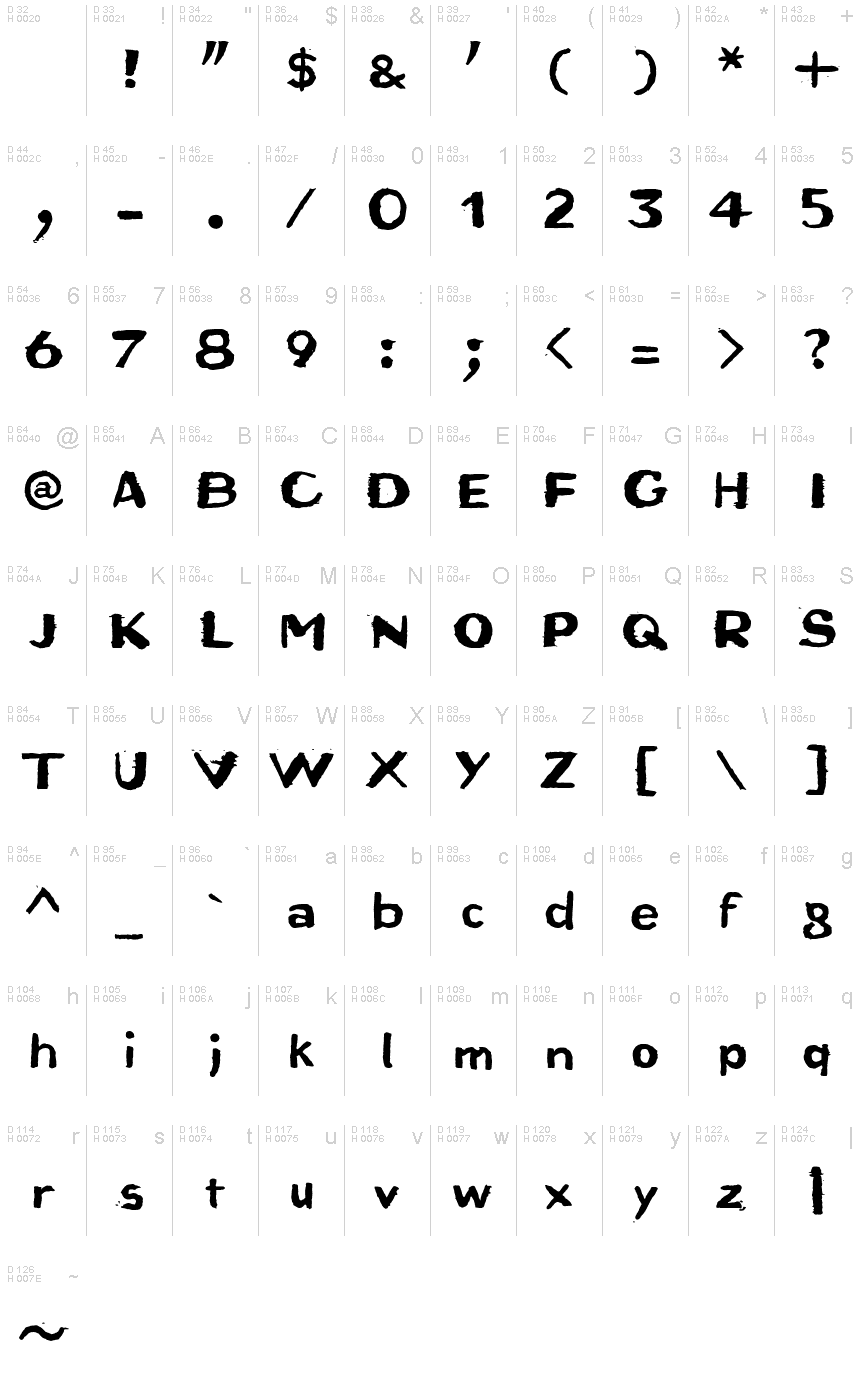Bruta Woodcut
TrueTypeБезкоштовна
- Hаголоси (часткові)
- Hаголоси (повні)
- Євро
Bruta_Woodcut.ttf
Теги
Примітка автора
Bruta Woodcut font is an eroded display font designed by Ingo Zimmermann.
An alphabet originally carved in wood
The German term for characters or letters is Buchstaben, literally Buche (beech) and Stab (rod or stick), and dates back to the Germanic custom of carving runic characters in beechwood sticks. On New Years Eve, 2014, I used the occasion to cut real beech characters myself. I carved all the characters of this font in woodcarving manner, without tracing and mirror-inverted, in smoothly planed beech rods. After printing on paper, the digital font you see here was created from the negative typeface.
Originally planning an alphabet of capital letters only, I ended up carving figures, punctuation marks and lower case letters after all. The capital letters emphasize alternation between bold and fine strokes, which is familiar in Roman typefaces. In this way, the upper case text in Bruta Woodcut obtains its very own aesthetics.
The ductus on the lower case letters is plainly not as distinct. They look more like a classical sans serif, which becomes clear as the smaller a text is set in Bruta Woodcut, the more legible it becomes.
The original image was negative. In contrast, the font consists of the positive typeface. Bruta Woodcut includes lots of ligatures and stylistic alternates for some symbols.
Thanks to OpenType and Unicode, Bruta Woodcut supports all Western European languages plus Central and Eastern European languages as well as Turkish.
An alphabet originally carved in wood
The German term for characters or letters is Buchstaben, literally Buche (beech) and Stab (rod or stick), and dates back to the Germanic custom of carving runic characters in beechwood sticks. On New Years Eve, 2014, I used the occasion to cut real beech characters myself. I carved all the characters of this font in woodcarving manner, without tracing and mirror-inverted, in smoothly planed beech rods. After printing on paper, the digital font you see here was created from the negative typeface.
Originally planning an alphabet of capital letters only, I ended up carving figures, punctuation marks and lower case letters after all. The capital letters emphasize alternation between bold and fine strokes, which is familiar in Roman typefaces. In this way, the upper case text in Bruta Woodcut obtains its very own aesthetics.
The ductus on the lower case letters is plainly not as distinct. They look more like a classical sans serif, which becomes clear as the smaller a text is set in Bruta Woodcut, the more legible it becomes.
The original image was negative. In contrast, the font consists of the positive typeface. Bruta Woodcut includes lots of ligatures and stylistic alternates for some symbols.
Thanks to OpenType and Unicode, Bruta Woodcut supports all Western European languages plus Central and Eastern European languages as well as Turkish.
Таблиця символів
Для перегляду різних таблиць символів для цього шрифту, будь ласка, скористайтесь меню, що розкривається.

Основна інформація про шрифт
Про авторські права
Copyright (c) 2015 by Ingo Zimmermann. All rights reserved.
Сімейство шрифту
Bruta
Підсімейство шрифту
Woodcut
Унікальний ідентифікатор підсімейства
IngoZimmermann: Bruta Woodcut: 2015
Повна назва шрифту
Bruta Woodcut
Ім´я настільної версії
Version 1.007
Ім´я поскрипт шрифта
Bruta-Woodcut
Про торгову марку
Bruta Woodcut is a trademark of Ingo Zimmermann.
Про виробника
Дизайнер
Опис
Copyright (c) 2015 by Ingo Zimmermann. All rights reserved.
Розширена інформація про шрифт
Платформи підтримуються
ПлатформаКодування
ЮнікодЮникод 2.0 и прогресивна семантика, тільки Юникод BMP
MacintoshЛатинська
MicrosoftТільки BMP юникод
Деталі шрифту
Створено2015-01-06
Перегляд1
Кількість гліфів364
Одиниць на Em1000
Права вбудовуванняBбудовування для стаціонарної установки
Клас групиВільні засічки
НасиченістьЖирний
ШиринаНапів–розширенний
Mac стильЖирні
НапрямокТільки гліфи спрямовані зліва направо + нейтральні
ВізерунокPегулярний
ВисотаНе моноширинний
